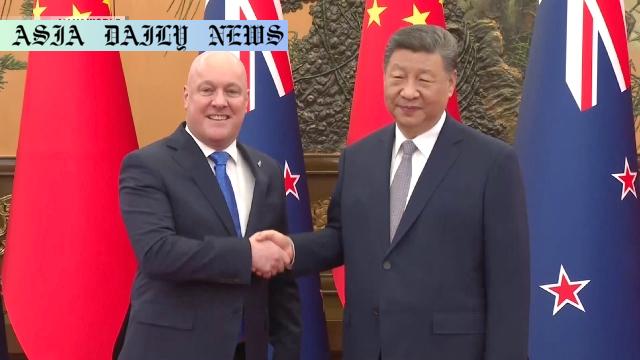Economic Ties: Prime Minister Luxon and President Xi affirm the importance of trade and cooperation between New Zealand and China.

New Zealand and China Reaffirm Economic Collaboration
In a significant meeting on Friday, New Zealand’s Prime Minister Christopher Luxon met with Chinese President Xi Jinping in Beijing to solidify the longstanding economic relationship between the two nations. This marks Luxon’s first visit to China since assuming office in November 2023. Recognizing China as New Zealand’s largest trading partner, Luxon emphasized the importance of maintaining healthy bilateral relations, with a particular focus on expanding cooperation in education and tourism sectors. Prime Minister Luxon underscored the tangible benefits these ties have delivered to both nations, further reinforcing New Zealand’s strategic priorities in Asia.
Challenges Emerging Amid China’s Bid for CPTPP Membership
While the reaffirmation of economic ties was the key highlight, another critical issue on the agenda was China’s desire to join the Comprehensive and Progressive Agreement for Trans-Pacific Partnership (CPTPP). New Zealand, already a signatory of the CPTPP, finds itself in a diplomatic predicament: although China’s inclusion could bring significant opportunities for trade, other member nations have raised concerns regarding the ability of China to meet the stringent standards of the agreement. This sensitive topic continues to pose challenges for New Zealand as it balances its commitments to CPTPP members with fostering strong ties with China.
Shifting Dynamics in the Pacific: The Cook Islands Factor
The meeting also occurred against the backdrop of emerging tensions in the Pacific, particularly concerning the Cook Islands. New Zealand recently decided to halt millions of dollars in financial aid to the Cook Islands after it signed a strategic security partnership agreement with China without prior consultation. The Cook Islands’ move strained its obligations to New Zealand regarding consultation on defense and security matters. This development reflects the broader geopolitical shifts and the influence of China in the Pacific region, placing New Zealand in a delicate position as it seeks to navigate these new challenges.
Opportunities in Education and Tourism
Despite these challenges, both New Zealand and China identified education and tourism as promising areas for strengthening collaboration. As travel between the countries picks up post-pandemic, there are opportunities to increase student exchanges and tourism revenues, fostering people-to-people connections while driving economic growth. This shared interest in cultural and educational exchange highlights the potential of soft diplomacy in further enhancing the bilateral relationship.
Conclusion: Maintaining Balance in a Complex Relationship
The discussions between Luxon and Xi underscore the complexity of the relationship between New Zealand and China. While economic cooperation remains paramount for New Zealand, navigating geopolitical tensions, trade alliance negotiations, and regional security issues will be critical in maintaining the trust and mutual benefits this partnership offers. With significant opportunities on the horizon, New Zealand must tread carefully to balance its internal economic priorities with external pressures from its allies and regions.
Commentary
Economic Cooperation at the Forefront
The meeting between New Zealand’s Prime Minister Christopher Luxon and Chinese President Xi Jinping is a reminder of the importance of strong economic partnerships in today’s interconnected world. For New Zealand, maintaining robust trade relations with China, its largest trading partner, is vital to sustaining both its export-driven economy and its influence within the Asia-Pacific region. The focus on education and tourism as areas of collaboration is particularly intriguing, as these sectors go beyond just economic benefits—they have the power to strengthen cultural ties and foster mutual understanding between the two nations.
Navigating the CPTPP Debate
China’s lobby to join the CPTPP, however, adds a layer of complexity to the relationship. This is not just a bilateral issue but a multilateral challenge that places New Zealand at the crossroads of global trade diplomacy. On one hand, Beijing’s entry could open up new economic opportunities, but on the other hand, the skepticism of other treaty members makes this a challenging proposition. The situation underlines New Zealand’s unique position in serving as a bridge between Western trade alliances and China’s growing influence.
Geopolitical Maneuvering in the Pacific
The Cook Islands’ recent partnership with China adds another dimension to the discussion. While the suspension of financial aid by New Zealand signals discontent, this move reflects the rapidly shifting geopolitical dynamics in the Pacific region. This is a wake-up call for New Zealand to reassess its approach in dealing with smaller Pacific nations, especially as China’s reach grows in strategic sectors like defense and infrastructure. Strengthening regional alliances and fostering open dialogue will be key to managing these changes effectively.
Conclusion: Opportunities and Complexities Ahead
As New Zealand continues to work with China, it is clear that while opportunities abound, complexities remain unavoidable. Whether it’s trade agreements, regional dynamics, or sectoral collaborations, every decision will require careful consideration of both domestic and international implications. This meeting between Luxon and Xi is a step forward in reaffirming their partnership, but the road ahead will demand more nuanced diplomacy and strategic vision.


